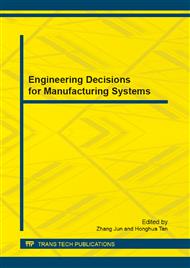p.460
p.467
p.473
p.478
p.485
p.490
p.495
p.502
p.508
The State Recognition for Rotary Machines Based on Fractal Theory and Neural Network
Abstract:
A new state recognition method for rotary machines based on the fractal theory and neural network is proposed, and it is analyzed with the example of bushing abrasion of the connecting rod in diesel engine. Firstly, the wavelet theory is used to reduce noises in the vibration signals and then pick up the generalized fractal dimensions with different iterative steps. They will be the input parameters of the RBF neural network, and the output ones are the four working states. After being trained, the model of neural network can identify the states by the vibration signals. According to the experiment and simulation, the wavelet noise reduction can reproduce the vibration signals clearly and optimize the state recognition. The method based on the fractal theory and neural network is demonstrated to be efficient and feasible, and it can identify the states correctly. It has preferable engineering applicability and the referenced value to other vibration diagnosis of rotary machines.
Info:
Periodical:
Pages:
485-489
Citation:
Online since:
September 2013
Authors:
Keywords:
Price:
Сopyright:
© 2013 Trans Tech Publications Ltd. All Rights Reserved
Share:
Citation:


